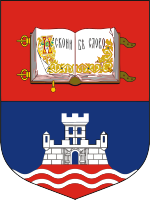Great School
| Универзитет у Београду Univerzitet u Beogradu |
|
 |
|
| Type | Public |
|---|---|
| Established | Belgrade Higher School, 1808 University of Belgrade, 1905 |
| Rector | Vladimir Bumbaširević |
|
Academic staff
|
4,289 |
| Students | 89,827 |
| Location | Belgrade, Serbia |
| Campus | Urban |
| Colours | |
| Affiliations |
EUA Erasmus DAAD AUF DRC |
| Website | www |
 |
|
The University of Belgrade (Serbian: Универзитет у Београду / Univerzitet u Beogradu) is the oldest and the largest university in Serbia.
Founded in 1808 as the Belgrade Higher School in revolutionary Serbia, by 1838 it merged with the Kragujevac-based departments into a single university. The University has nearly 90,000 students (including around 1,700 postgraduates) and over 4,200 members of teaching staff. Since its founding, the University has educated more than 330,000 bachelors, around 21,300 magisters, 29,000 specialists and 12,600 doctors. The University comprises 31 faculties, 12 research institutes, the university library, and 9 university centres. The faculties are organized into 4 groups: social sciences and humanities; medical sciences; natural sciences and mathematics; and technological sciences.
On the prestigious Shanghai Ranking (ARWU), the University of Belgrade ranks between 201st and 300th place, according to the most recent (2016) global ranking. In 2014 it ranked 151-200 specifically in the areas of mathematics and physics.
The University of Belgrade was established in 1808 as the Belgrade Higher School (Serbian: Велика школа, a Grande École) by Dositej Obradović, Serbian key figure in the Age of Enlightenment. It was the highest ranking educational institution in Serbia between 1808 and 1905, as the first Higher School (1808–1813), the Belgrade Lyceum (1838–1863), and the second Higher School (1863–1905). It was initially located at the Countess Ljubica's Residence building and then moved to another significant site in Belgrade, the Captain Miša’s Mansion, today's seat of the university.
...
Wikipedia
